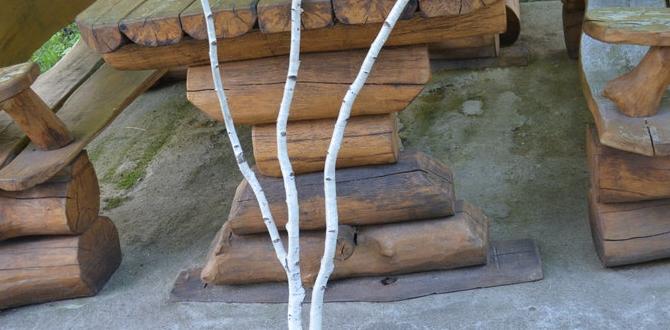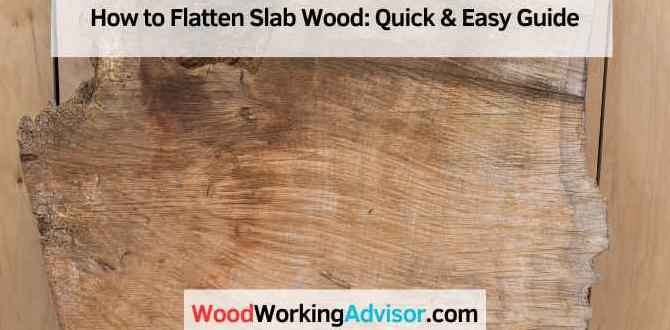To disassemble and clean your brad nailer, simply unplug it, remove the magazine, trigger safety mechanism, and then carefully take apart the main body following your tool’s manual. Clean parts with a dry cloth or specific lubricant, ensuring no debris remains before reassembly. This process guarantees optimal performance and longevity for your tool.
Hey there, fellow woodworkers and DIYers! Jack Shaffer here from Nailerguy. Is your trusty brad nailer acting a bit sluggish? Maybe it’s not sinking nails as deep as it used to, or perhaps it’s jamming more often than you’d like. It can be frustrating when a tool that’s supposed to make your projects smoother starts causing headaches. The good news is, most of these issues can be fixed with a good old-fashioned cleaning and a little bit of careful disassembly. Don’t worry if you’ve never taken one apart before; I’m here to guide you through it step-by-step. We’ll get your brad nailer back in top shape, ready for your next crafting adventure! Let’s dive in and learn how to bring your brad nailer back to life.
Table of Contents
Why Cleaning and Disassembly Matter for Your Brad Nailer
Think of your brad nailer like any other finely tuned machine. Over time, dust, wood fibers, and even tiny bits of metal can accumulate inside. This gunk can gum up the works, preventing the piston from moving freely or obstructing the nail feed. Regular maintenance, including thorough cleaning and occasional disassembly, is key to preventing major issues and keeping your tool reliable. It’s also a fantastic way to understand your tool better, spotting potential problems before they become costly repairs. Plus, a clean tool is a safer tool!
This guide will walk you through the process safely and effectively. We’ll cover everything from the basic tools you’ll need to the specific steps for most common brad nailers. By the end, you’ll have the confidence to tackle this task yourself, saving you time and money while ensuring your brad nailer performs like new for years to come.
Essential Tools for Brad Nailer Maintenance
Before we start taking things apart, it’s good to have the right tools on hand. You won’t need a whole workshop for this, just a few common items. Having these ready will make the process much smoother.
Here’s what you should gather:
Safety Glasses: Always protect your eyes! Tiny springs or parts can pop out unexpectedly.
Gloves: To keep your hands clean and improve grip.
Microfiber Cloths: For wiping down parts without leaving lint.
Small Screwdriver Set: Flathead and Phillips head screwdrivers in various small sizes are essential. Check your nailer’s manual if it specifies particular types.
Allen Wrench (Hex Key): Many brad nailers use these for disassembly. They often come with the tool, but keep a set handy.
Nailer Lubricant: Use a lubricant specifically designed for pneumatic tools. A few drops are all you need. Avoid using WD-40 as a lubricant, as it can attract dust and eventually cause more problems.
Compressed Air (Optional but Recommended): A can of compressed air or an air compressor with a blowgun attachment is great for blasting away stubborn dust and debris.
Small Container or Tray: To keep track of all the small screws and parts you remove. This is super important!
Owner’s Manual: This is your best friend! Each brad nailer model can have unique components. Always refer to your specific manual for detailed diagrams and instructions.
Before You Begin: Safety First!
Working with tools, even when they’re not powered, requires a safety-first mindset. We can’t stress this enough. A brad nailer, even when disconnected from air, can hold residual pressure or have spring-loaded components that could cause injury if mishandled.
Here are the critical safety steps:
1. Disconnect Power: For pneumatic nailers, disconnect the air hose completely from the tool. For cordless electric models, remove the battery. For corded electric models, unplug them from the power source. This is the most crucial step.
2. Remove All Nails: Make sure the magazine is completely empty of nails. Cycle the trigger a few times (without air/battery) to ensure no nail is jammed or ready to fire.
3. Engage Safety Mechanism: If your nailer has a secondary safety lock or switch, engage it.
4. Work in a Well-Lit Area: Good lighting helps you see what you’re doing and identify all parts.
5. Keep Workspace Tidy: A cluttered workspace increases the risk of losing small parts or tripping.
Step-by-Step Guide: Disassembling Your Brad Nailer
The exact disassembly process can vary slightly between brands and models, but the general principles are the same. Always consult your owner’s manual for model-specific instructions and diagrams.
Step 1: Remove the Magazine and Clear the Path
This is the first and most straightforward step. The magazine is where the nails are stored. It usually latches or slides off.
- Locate the magazine release lever or button. It’s typically near the front of the tool where the nails feed.
- Press or slide the release to detach the magazine.
- Once the magazine is off, check the nail feed path to ensure no nails are left inside.
Step 2: Remove the Trigger Safety Mechanism (if applicable)
Some brad nailers have a removable safety contact point or nose piece that can be disassembled. This part prevents the nailer from firing unless it’s pressed against a surface. Your manual will show if this is a separate component you can remove before proceeding.
- Identify the safety contact tip (the part that touches the wood).
- Look for screws or a retaining mechanism that holds it in place.
- Use the appropriate screwdriver or Allen wrench to remove any fasteners.
- Carefully slide or pull the safety mechanism off. Keep track of any springs or small parts.
Step 3: Accessing the Piston and Driver Assembly
This is where things start to get more involved. Most brad nailers allow you to access the internal piston and driver blade by removing a cap or housing at the rear of the tool, or sometimes from the front nose assembly. Again, your manual is key here.
A. Rear Cap Disassembly (Common for many pneumatic models):
- Locate the cap at the very back of the nailer’s handle.
- You’ll usually see a screw or a locking ring here.
- Use your screwdriver or Allen wrench to loosen and remove the screw, or twist the locking ring counter-clockwise.
- Once the fastener is removed, gently pull or lift the rear cap off. Be prepared for a spring to potentially push this cap outwards, so hold it firmly.
- Inside, you’ll see the main spring and the piston/driver assembly.
B. Nose Assembly Disassembly (Less common for cleaning the main piston but for other maintenance):
- Some models might require minor disassembly of the nose area for specific cleaning.
- Look for small screws around the very front of the nailer.
- Carefully remove these screws and gently pry off any covering plates.
- Be aware of the driver blade within this assembly and handle it with care.
Step 4: Removing the Piston and Driver Blade
With the housing or cap removed, you should be able to slide out the piston and driver blade assembly. This is the heart of the nailer.
- Carefully pull the piston assembly out of the cylinder. It might have the driver blade attached or seated within it.
- Note the orientation of the piston and driver blade. It’s crucial for reassembly! Taking a photo with your phone can be very helpful here.
- The driver blade is a slender, sharp piece of metal that strikes the nail. Handle it with extreme care to avoid injury.
Important Note: If your manual indicates further disassembly of the piston from the driver blade, follow those instructions precisely. Some driver blades are permanently attached, while others might have a retaining clip or screw.
Cleaning Your Brad Nailer Components
Now that your brad nailer is in pieces, it’s time to clean it up! The goal is to remove any accumulated dust, wood debris, or old lubricant.
A. Cleaning the Piston and Driver Blade:
- Use a dry, lint-free cloth to wipe down the piston and the driver blade.
- Pay close attention to the sides of the piston and the edges of the driver blade, where debris tends to stick.
- If there’s stubborn gunk, you can use a tiny bit of cleaning solvent on the cloth, but ensure it’s all evaporated or wiped clean before proceeding.
- Inspect the driver blade for any nicks or damage. A damaged driver blade can lead to misfires or bent nails.
B. Cleaning the Cylinder and Housing:
- Wipe the inside of the cylinder thoroughly with a clean cloth.
- Use compressed air to blow out any remaining dust or debris from all cavities and passages.
- Clean the exterior of the tool, paying attention to the trigger area and the magazine feed channel.
C. Cleaning the Magazine and Other Parts:
- Wipe down the inside and outside of the magazine.
- Ensure the feed mechanism within the magazine is free of obstructions.
- Clean any other small springs, O-rings, or seals you may have removed. Do not use solvents on rubber O-rings, as it can degrade them.
A clean tool is a more efficient tool. Keeping the internal components free of debris allows for smooth operation and prevents premature wear. For more detailed information on tool maintenance, the U.S. Department of Labor’s Occupational Safety and Health Administration (OSHA) provides extensive resources on maintaining all types of tools safely.
Lubrication: Essential for Smooth Operation
Lubrication is critical for the longevity and smooth operation of your brad nailer. It reduces friction between moving parts, prevents wear, and keeps seals supple.
When to Lubricate:
After thorough cleaning.
When you notice reduced performance.
As recommended by your manufacturer (usually every few thousand nails or annually).
How to Lubricate:
- Apply just 1-2 drops of pneumatic tool oil (e.g., Ingersoll Rand Air Tool Oil) to the piston.
- Ensure the oil evenly coats the piston surface.
- If your manual specifies, apply a tiny amount of grease to the O-rings or seals.
- Do NOT over-lubricate. Too much oil can attract dust and create a sticky residue, leading to more problems.
It’s always best to use a lubricant specifically designed for pneumatic tools. These oils are formulated to work with the O-rings and seals found in air-powered equipment and also have anti-gumming properties.
Reassembling Your Brad Nailer
Reassembly is essentially performing the disassembly steps in reverse order. Take your time and refer to your photos and the diagrams in your owner’s manual.
- Insert Piston and Driver Assembly: Carefully slide the piston and driver blade back into the cylinder. Make sure it’s oriented correctly – the driver blade should align with the nail egress point at the nose.
- Re-attach Rear Cap/Housing: Place the rear cap or housing back into position. If there was a spring, ensure it’s seated correctly and doesn’t interfere with the piston. Secure it with its screw or locking ring. Don’t overtighten.
- Re-install Safety Mechanism: If you removed the safety contact point, reassemble it now, ensuring all springs and parts are in place. Secure it with its fasteners.
- Attach Magazine: Slide the magazine back onto the tool until it clicks or locks into place.
- Check for Smoothness: Gently operate the trigger a few times (still without air or battery connected) to ensure the piston moves freely and the driver blade engages smoothly.
If at any point you feel resistance or can’t get a part to fit, stop. Double-check your steps and the manual. Forcing parts can damage your tool.
Testing Your Cleaned Brad Nailer
You’ve reassembled your brad nailer, so now it’s time for the moment of truth!
- Connect Air/Battery: Connect the air hose (ensure regulated pressure is within the manufacturer’s recommended range, usually 70-100 PSI for brad nailers) or re-insert the battery.
- Load Nails: Load a strip of brads into the magazine.
- Test Fire: Hold the nailer against a scrap piece of wood and pull the trigger.
- Inspect Results: Check if the nail is driven cleanly and to the desired depth. Test fire a few more times.
If your brad nailer is now firing perfectly, congratulations! If you encounter issues, revisit the disassembly and cleaning steps, paying close attention to any parts you might have overlooked. Sometimes, a small piece of debris can cause a big problem.
Common Brad Nailer Problems and How Cleaning Helps
Let’s look at some typical brad nailer hiccups and how a good cleaning can often solve them:
| Problem | Likely Cause | How Cleaning Helps |
| :———————— | :———————————————– | :—————————————————————————————- |
| Nails not sinking deep | Lack of air pressure, clogged piston/cylinder, worn driver bumper | Cleaning removes debris, allowing piston to strike with full force. |
| Jamming nails | Debris in feed mechanism, bent driver blade, improper nail size | Cleaning clears obstructions. Ensures driver blade moves freely. Inspect blade for damage. |
| Leaking air | Worn O-rings or seals, loose connections | While cleaning doesn’t replace worn seals, it ensures they are seated correctly. Check all housing screws. |
| Inconsistent firing | Debris in trigger assembly, weak spring | Cleaning ensures the trigger mechanism is free to operate. |
| Tool won’t fire | Safety contact obstructed, internal jam | Removing debris from safety contact and internal parts ensures proper function. |
Regular cleaning, as outlined in this guide, is the best preventative maintenance. It addresses the root causes of many common operational issues, prolonging the life of your tool and ensuring it performs reliably when you need it most. For more on pneumatic tool maintenance, resources like Tool Crib offer great practical advice.
Maintaining Different Types of Brad Nailers
While this guide focuses on the general principles, there are slight variations for different power sources:
Pneumatic Brad Nailers: These are the most common and often the easiest to disassemble. They rely on compressed air, and their internal mechanisms are typically straightforward. The steps above apply very well to pneumatic models.
Cordless Electric Brad Nailers (Battery-Powered): These have a motor and battery pack. Disassembly is similar, but you’ll obviously need to remove the battery. Be mindful of electrical components and wiring. Avoid getting liquid lubricants near the motor.
* Electric Brad Nailers (Corded): Very similar to cordless electric, but you’ll be unplugging it instead of removing a battery. Again, avoid lubricants on electrical parts.
Always check your specific manual. If you have a hybrid model or a unique design, the manufacturer’s documentation is your definitive source.
Frequently Asked Questions About Brad Nailer Maintenance
Q1: How often should I disassemble and clean my brad nailer?
For most DIYers, a thorough cleaning and lubrication every 6-12 months or after intensive projects is sufficient. If you use your nailer daily for professional work, you might need to clean it more frequently, perhaps every few thousand nails, as recommended by the manufacturer.
Q2: Can I spray lubricant directly into the air inlet?
Some air tool manufacturers recommend a few drops of oil in the air inlet as part of a daily maintenance routine. However, for deep cleaning and lubrication of internal parts like the piston, it’s best to manually apply oil directly to the components after disassembly. Avoid spraying general-purpose lubricants like WD-40 into the air inlet; use specialized pneumatic tool oil.
Q3: My brad nailer is still jamming after cleaning. What else could it be?
If jams persist after cleaning, check the nails you are using. Ensure they are the correct size, brand, and type for your nailer. Also, inspect the driver blade for any bending or damage. If the blade is damaged, it will need replacement. If you used the wrong type of lubricant, it might also be attracting dust and causing jams.
Q4: What kind of lubricant should I use?
You should use a high-quality pneumatic tool oil or air tool lubricant.



